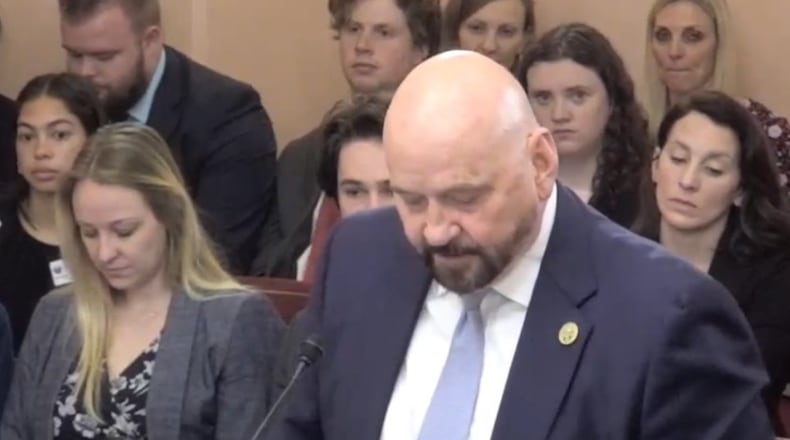“On average, the United States pays twice as much for prescriptions compared to other high-income developed nations,” said State Rep. Tom Young (R-Washington Twp.), who is sponsoring H.B. 92 with State Rep. Nick Santucci (R-Howland Township).
“In an effort to lower drug prices for consumers across Ohio, we have introduced legislation that would allow the state of Ohio to contract with experienced, private companies to arrange the importation of drugs,” Young said.
The drugs would be required to be surplus or produced in excess of what the manufacturer normally makes to avoid negative supply chain internal issues, he said.
The bill includes an appropriation of $2 million for the Ohio Board of Pharmacy to import drugs.
“The imported drugs are still held to the same standards of quality assurance as if they were produced in the United States,” Young said.
Drug price increases vary between the types of drugs, but many outpace inflation. Over the period from January 2022 to January 2023, more than 4,200 drug products had price increases, of which 46% were larger than the rate of inflation, according to the Office of the Assistant Secretary for Planning and Evaluation (ASPE).
The price of Nerlynx, used to treat early stage breast cancer, increased by nearly 21% in 2020, while general inflation increased by 1.3% during that same period, AARP says.
The highest percentage increase in 2022 was for a drug approved to treat high blood pressure whose price increased more than 35-fold, from a list price of $4.32 to a new price of $158.72, according to ASPE.
The Ohio House Public Health Policy Committee held its second hearing of the proposed legislation. Substitutions introduced on Wednesday included calling for stockpiling, along with requiring the contractor to lease space with the Ohio Department of Health.
Young used the example of challenges experienced during the COVID-19 pandemic as another impetus for stockpiling.
“We witnessed firsthand the challenge we had in resources and taxpayer dollars when we don’t plan for emergencies,” Young said about the pandemic.
Young then cited the tornadoes and strong storms Ohio has seen this year.
“We don’t know when the next disaster is going to happen, but we know that we want to be prepared and we don’t want to waste taxpayers’ dollars being ill-prepared,” Young said.
Private companies can also handle the stockpiling, he said.
The Food and Drug Administration (FDA) recently developed a pathway under section 804 of the Federal Food, Drug, and Cosmetic Act that allows importation of certain prescription drugs from Canada. The pathway came into effect this year, and Florida was the first state to receive FDA approval for its importation program proposal in January, according to the National Conference of State Legislators, an organization created by state legislators and legislative staff in 1975.
The return on investment for this program will be “extremely impactful,” Young said. He said Florida is projecting savings around $100 million.
“We believe there will be extensive savings for the citizens of Ohio, as well as those in need,” Young said.
A handful of other states are seeking to make use of the FDA’s pathway to drug importation from Canada.
Seven states— Colorado, Florida, Maine, New Hampshire, New Mexico, Texas and Vermont —have passed importation legislation to establish a state drug importation program, according to the National Conference of State Legislators.
Five of those states—Colorado, Florida, Maine, New Hampshire and New Mexico—have submitted proposals to the FDA while Vermont submitted a concept letter to the U.S. Department of Health and Human Services and Office of Management and Budget. Texas has not yet submitted a proposal.
North Dakota and Virginia passed legislation establishing workgroups to examine the impact of a state importation program.
Some believe importing and stockpiling drugs isn’t the best path forward to reduce shortages and prices, says a trade group representing biotech and other life science industries in Ohio.
Canada has had its own issue with drug shortages, said Eddie Pauline, president and CEO of the Ohio Life Sciences Association.
“They’re not able to provide the demand this could potentially put on that country,” Pauline said. Canada’s population is just shy of 39 million people, according to the World Bank and StatCan. Florida’s population is more than half that at 22 million people, according to the U.S. Census.
To address our pricing issues and any of our shortage issues, Pauline said public policy should focus on incentivizing more infrastructure.
“Can the policy be more about how Ohio makes it easier for drug manufacturers to produce more drugs here? Can we incentivize more manufacturing facilities? Those are really the solution the state should be considering rather than thinking this could be solved by mandating buying drugs from Canada that seem to not be that available anyway,” Pauline said.
Canada is getting its drugs from the same manufacturers as the U.S., he said, adding that there are potential safety issues associated with importing drugs.
“Will the U.S. will know where the drugs coming from, are the drugs simply going through Canada, are they being made by facilities in Canada? There’s just a lot of questions about the oversight and safety of medicines coming from Canada that may not be thought about as well,” Pauline said.
About the Author


